In any given group of kids, it’s not a surprise to meet up with someone like the Big Cheese—the child who’s always bragging about being the best. Or to sit down next to the Couch Potato, the tech-savvy youngster for whom screen time is everything. And every educator has tried to soothe the worries of the Good Egg, the student who is cracking under the pressure of trying to be perfect. Along with consistently cropping up in classrooms, these recognizable personalities can also be found as characters in the New York Times bestselling Food Group series, featuring Pete Oswald’s comical and charming illustrations. Oswald has illustrated numerous whimsical picture books and is an Annie Award-nominated animation production designer.
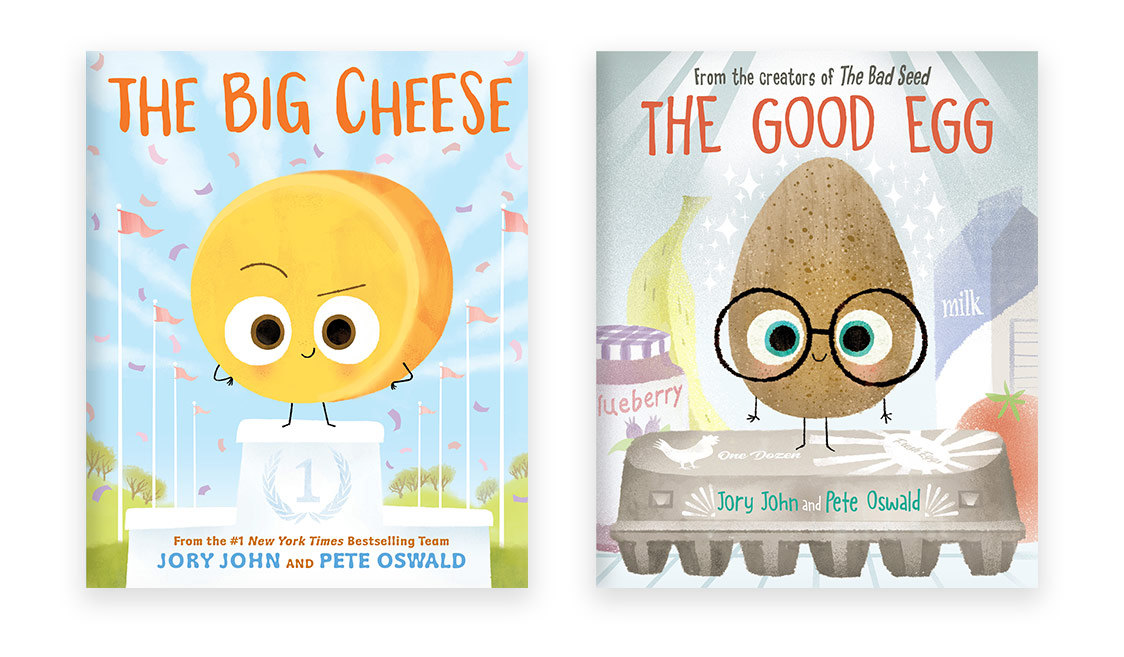
Here, Oswald talks with Lisa Bullard about illustrating picture books, helping children learn to name their emotions, and collaborating with the author of the Food Group series, Jory John.
One of the biggest delights of the Food Group series is how relatable the characters are. Young readers can easily identify with each of them despite their uncanny resemblance to grocery-store produce! Can you talk about the process you go through in bringing to life these personalities?
Creating the Food Group series with Jory John has been an incredible collaboration. The first book in the series was The Bad Seed (HarperCollins, 2017). Initially, it wasn’t intended to be a series. The focus was making a character that was full of humor and heart. I did a few sketches of a grumpy sunflower seed with a heavy brow. There was not much of a story. I thought there was something funny and relatable about this seed that wore his emotions on his sleeve, or should I say “shell.” Our editor sent my sketches to Jory John, and he brought the entire story to life. He and I spoke on the phone a few times, and we immediately hit it off. The initial sketches had a strong juxtaposition between cute and dangerous. Jory was able to tap into this contrast and create a comedic story with universal appeal. Jory’s manuscript is so original and evocative. I remember the first time I read it; the character jumped off the page. Oh, and the book is also a great read-aloud. Say it with me, “I’m a bad seed. A baaaaaaaaaaaad seed.”
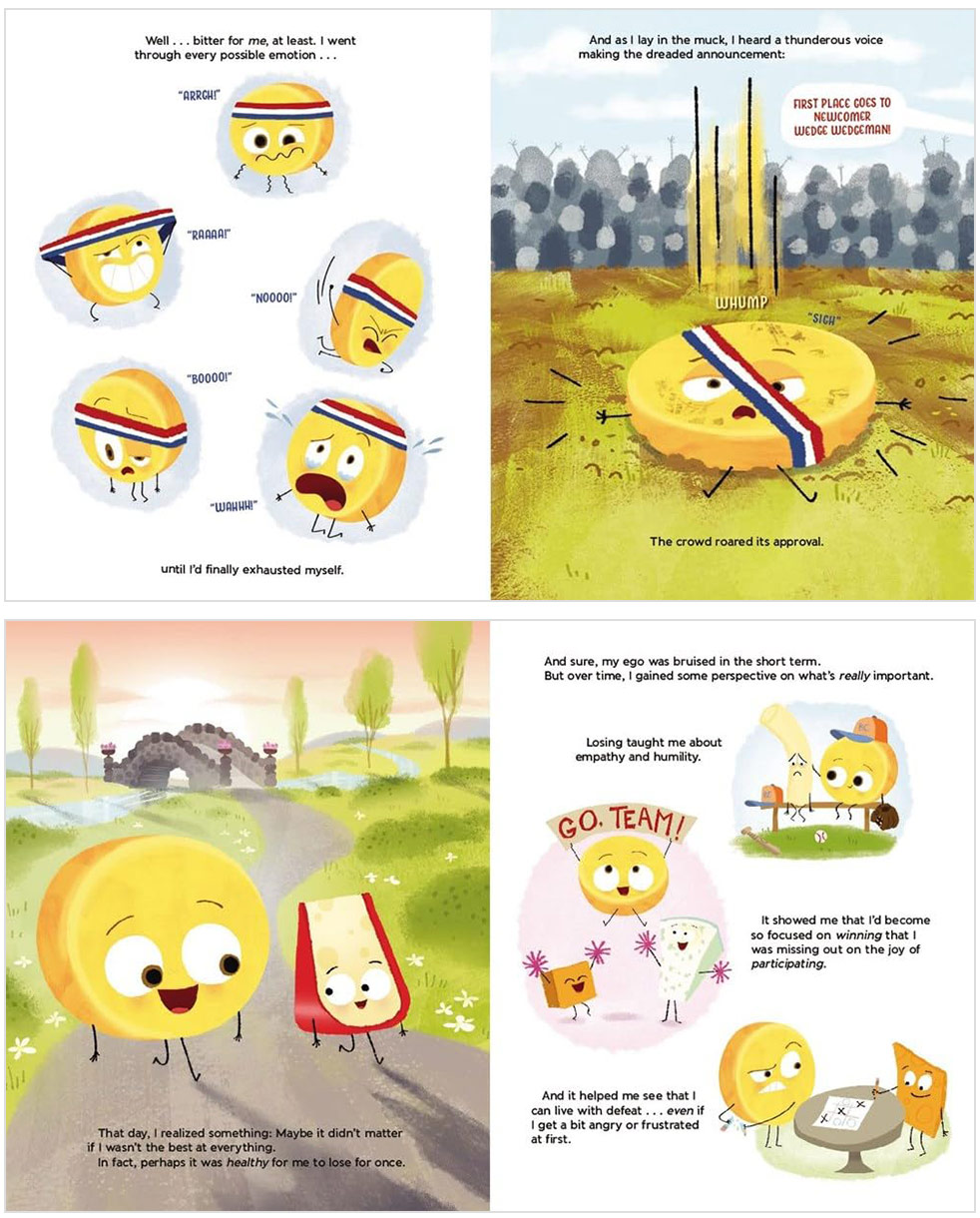
Spreads from The Big Cheese by Pete Oswald
Fortunately, many people have fallen in love with these Food Group characters, which has allowed us to expand the series. Currently there are six characters with a seventh on the way: The Big Cheese (HarperCollins) comes out November 7, 2023. The series has also branched out to include beginning reader titles such as The Bad Seed Goes to the Library (HarperCollins, 2022). Teachers and librarians are bringing the Food Group books into their classrooms and using them as part of their curriculum. This is the ultimate compliment!
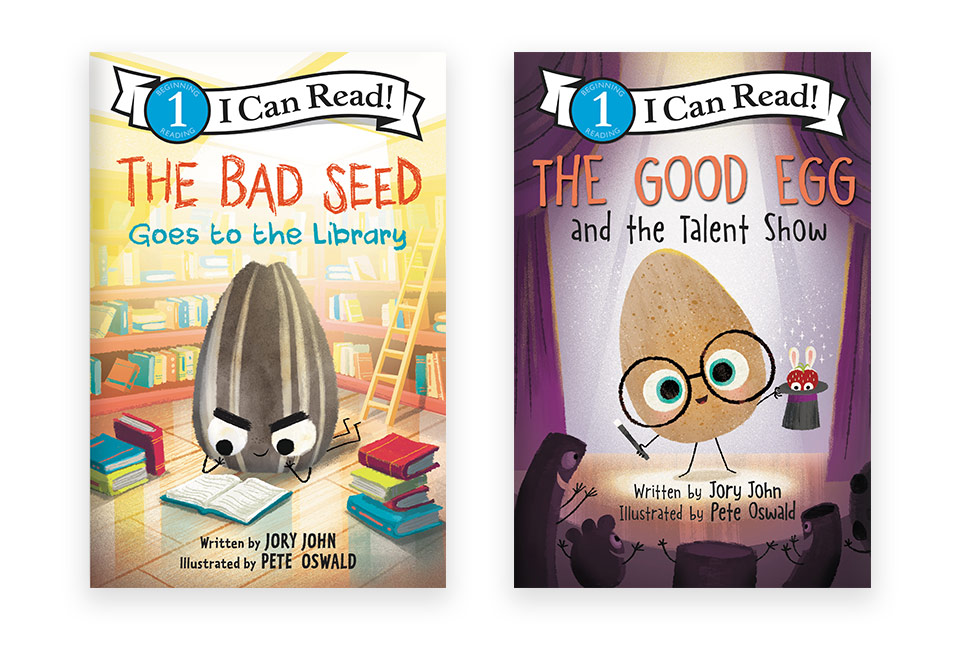
Teachers and librarians are bringing the Food Group books into their classrooms and using them as part of their curriculum. This is the ultimate compliment!”
Part of what gives this series such a strong appeal is that the titles help young readers/listeners focus on character education—but the books’ humor and human warmth keep them from feeling didactic. What are some of the techniques you use to convey the varied emotions of a grape or a bean?
Whether I’m drawing a potato, a cookie, or an egg, I’m always thinking about the emotions of the character and how the design relates to the story. As an illustrator, I love bringing inanimate objects to life. It’s more of a challenge to illustrate a personality-filled grape than a human child. Humor is the driving goal when illustrating the Food Group characters. I specifically kept their designs simple: broad shapes, large eyes, and tiny limbs. When I design a character, I start with the eyes. The eyes are the window into the character’s emotions. It is this relatability that helps the reader connect with the characters.

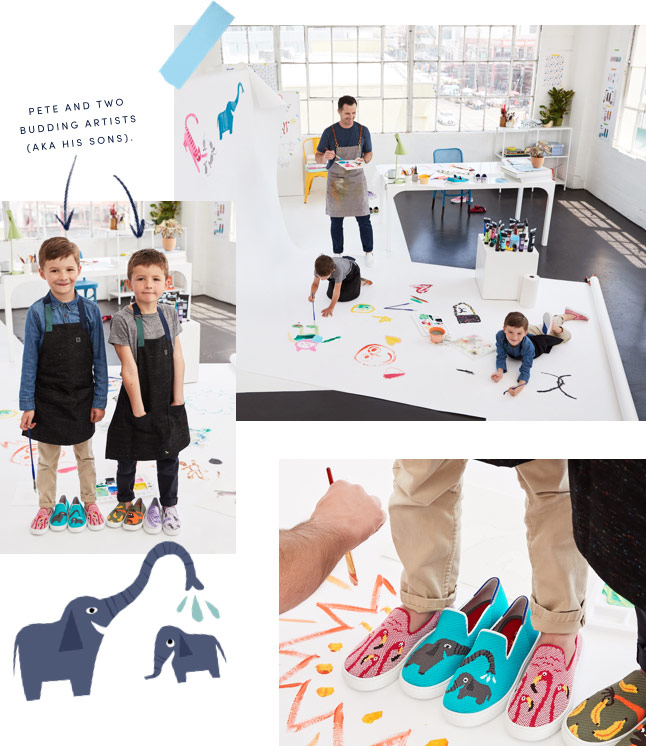
The eyes are the window into the character’s emotions.”
What has been the best part of collaborating on this ongoing series?
Jory and I actively collaborate on all the books in the series, and illustrating Jory’s brilliant manuscripts is an honor. He thinks very visually, so there are always tons of opportunities for comedic drawings. The magic of picture books is when the words and the pictures combine to create something unique and special. Connecting and becoming friends with Jory is by far the best part of this collaboration.
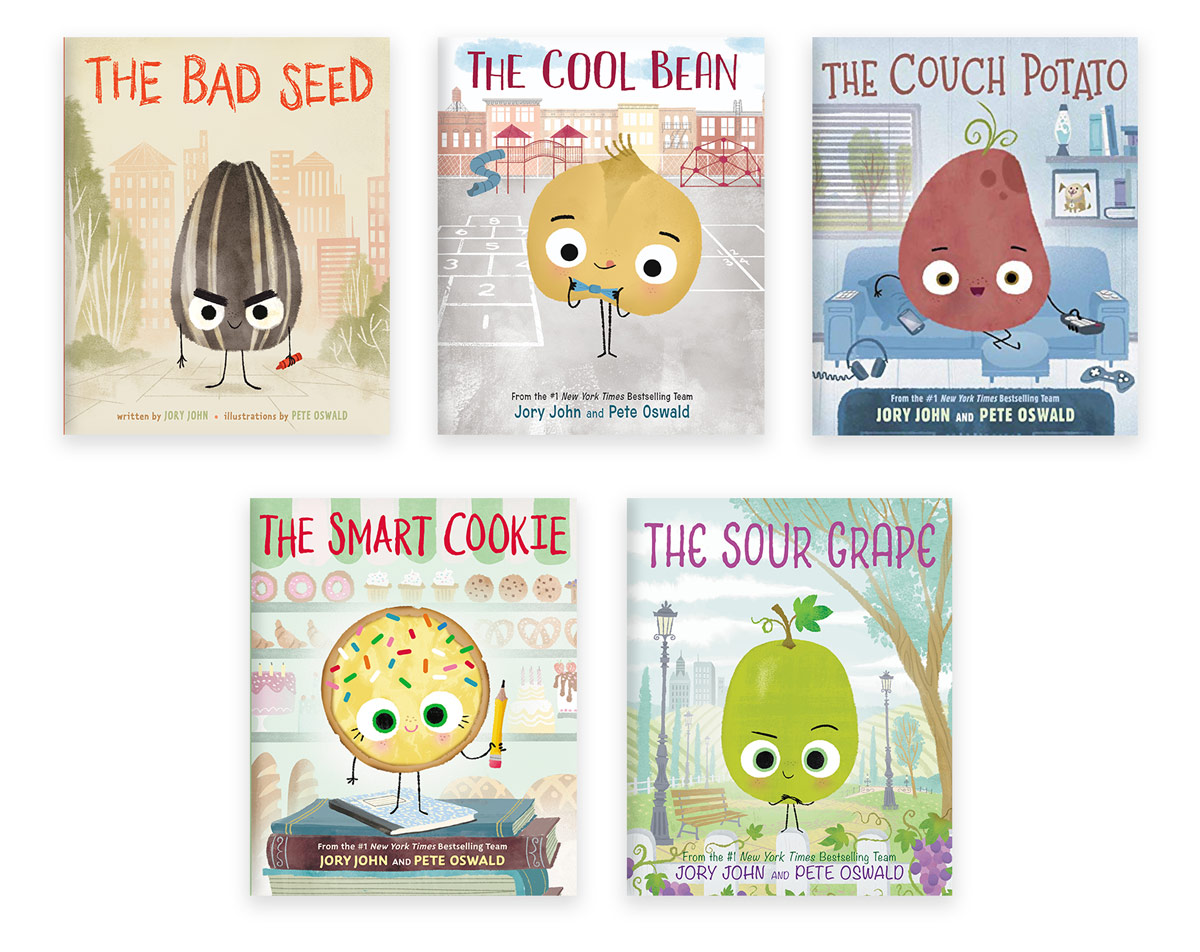
You’ve illustrated the books of many other authors as well. In what ways does your approach change with each different writer and story?
I’m very fortunate that I get to work with many different authors. This allows me to illustrate in many different styles. Every manuscript has a unique voice, so the illustrations need to support that. I love creating specific art styles that relate to the text. For example, when I read the manuscript for Being a Dog: A Tail of Mindfulness (HarperCollins, 2022) by Maria Gianferrari, I was moved by how mindful dogs are and how much humans can learn from them. So, I decided to give the illustrations a handmade, cut-out feel. The process involved cutting out each design by hand with an X-Acto knife. I had to take my time and be mindful, just like a dog. I would scan the different pieces of paper and then paint each page digitally in Photoshop. This was my most labor-intensive process yet. I leaned into the imperfections, which was quite freeing.
For Flat Cat (Flamingo Books) by Tara Lazar, which is coming out September 19, 2023, the text is so hilarious and packed full of visual comedy. Flat Cat is such a cool and smooth character, almost like a Hollywood star; I knew the art style had to reflect that. So, I chose to illustrate all the characters and environments with a thick-and-thin line inspired by one of my favorite caricaturists, Al Hirschfeld, while keeping Flat Cat self-colored (no lines). Flat Cat, though he is flat, is the most visually dimensional character in the book. Illustration is about creating visual contrast to help support the story. Without contrast, everything will appear the same.
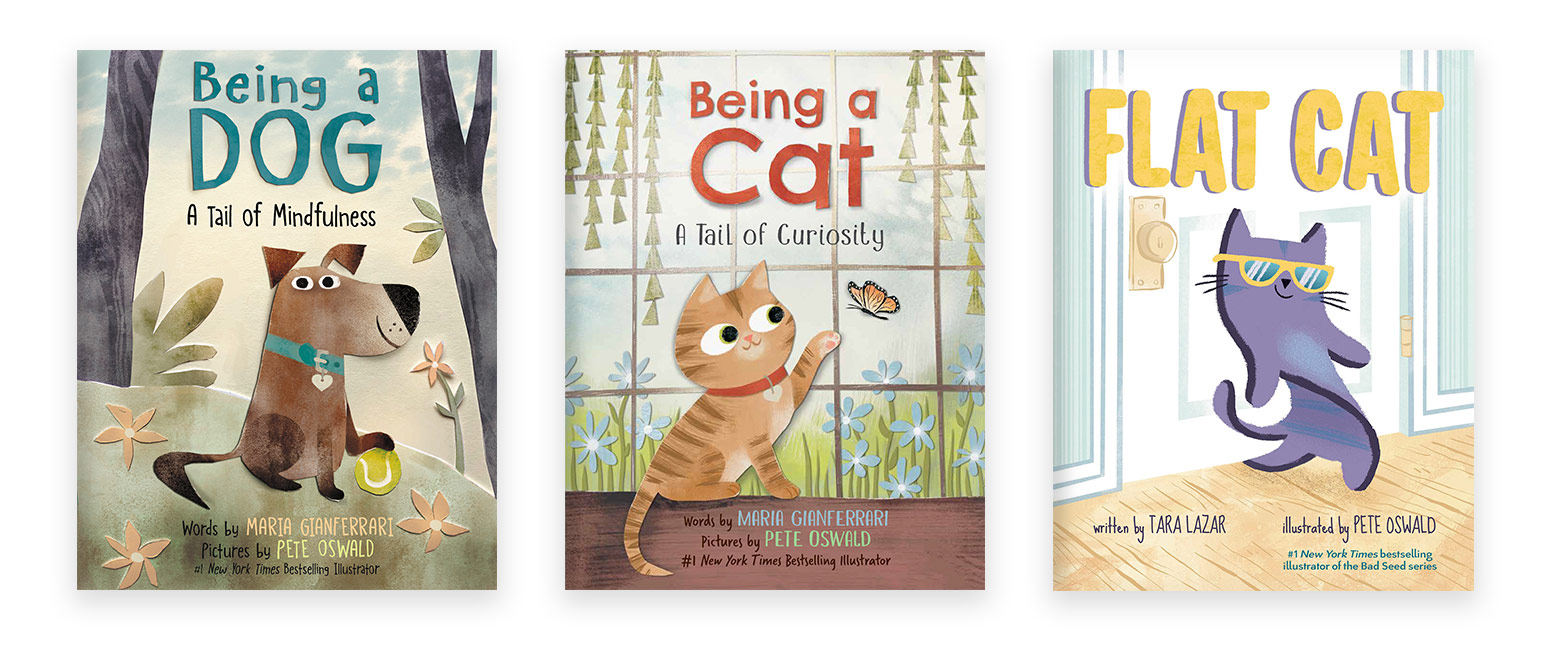
How does the process differ when you illustrate your own text as opposed to another writer’s words?
Illustrating my own text is an entirely different challenge. Hike (Candlewick, 2020) was my author/illustrator debut. It’s a wordless picture book that follows a child and father going on a hike in the mountains where they witness the magic of the wilderness, overcome challenges, and play a small role in the survival of the forest. Even though there are no words, I still had to create the narrative. This book is purely visual, so the illustrations had to carry the story. What I love about wordless picture books is that they force the reader to be an active participant. There is room for the reader to create his or her own ideas and make it personal.
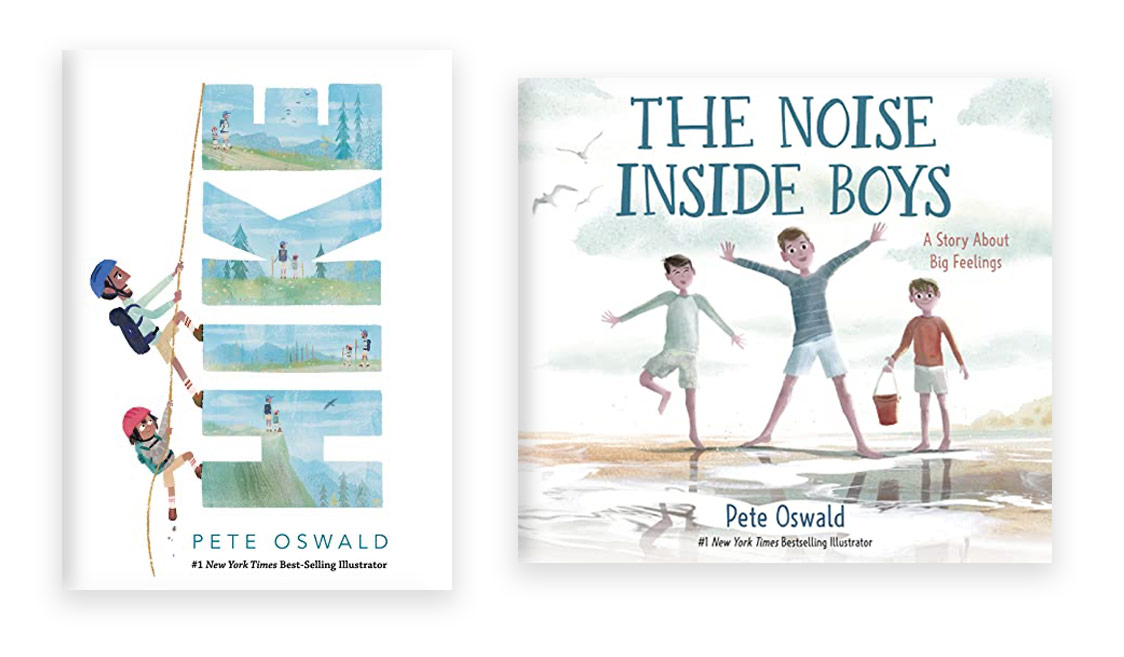
I both wrote and illustrated The Noise Inside Boys: A Story About Big Feelings (Random House Studio, 2023). It was based on a poem that I wrote for my three sons about learning to listen to your emotions. As a father of three boys, I understand that there are stereotypes associated with raising boys, and my hope is that this book plays a role in changing that. Through this story, I want to give children the vocabulary to describe their inner experiences and feelings, as I believe that when children can name their emotions, they can begin to understand them, learn how to harness emotional literacy, and become more resilient, coping better with life’s tougher moments.
Through this story, I want to give children the vocabulary to describe their inner experiences and feelings, as I believe that when children can name emotions, they can begin to understand them, learn how to harness emotional literacy, and become more resilient.”
Do you have any advice for young artists and writers?
My advice for young artists is to be present. Whether you want to become an author or an illustrator, or both, you need life experiences to create your stories. Everyone has a unique story to tell. By being mindful and living in the present, you can fully experience life, which in turn will lead you to the best and most personal stories to share. Oh, and don’t forget to read … a lot.
My advice for young artists is to be present. … Everyone has a unique story to tell. By being mindful and living in the present, you can fully experience life, which in turn will lead you to the best and most personal stories to share.”
What are the best ways for readers to connect with you or to follow you on social media?
Visit me at peteoswald.com and follow my Instagram @peteoswald.
To find downloadable activities for the Food Group series, visit:
https://www.harpercollins.com/pages/childrens-the-food-squad






